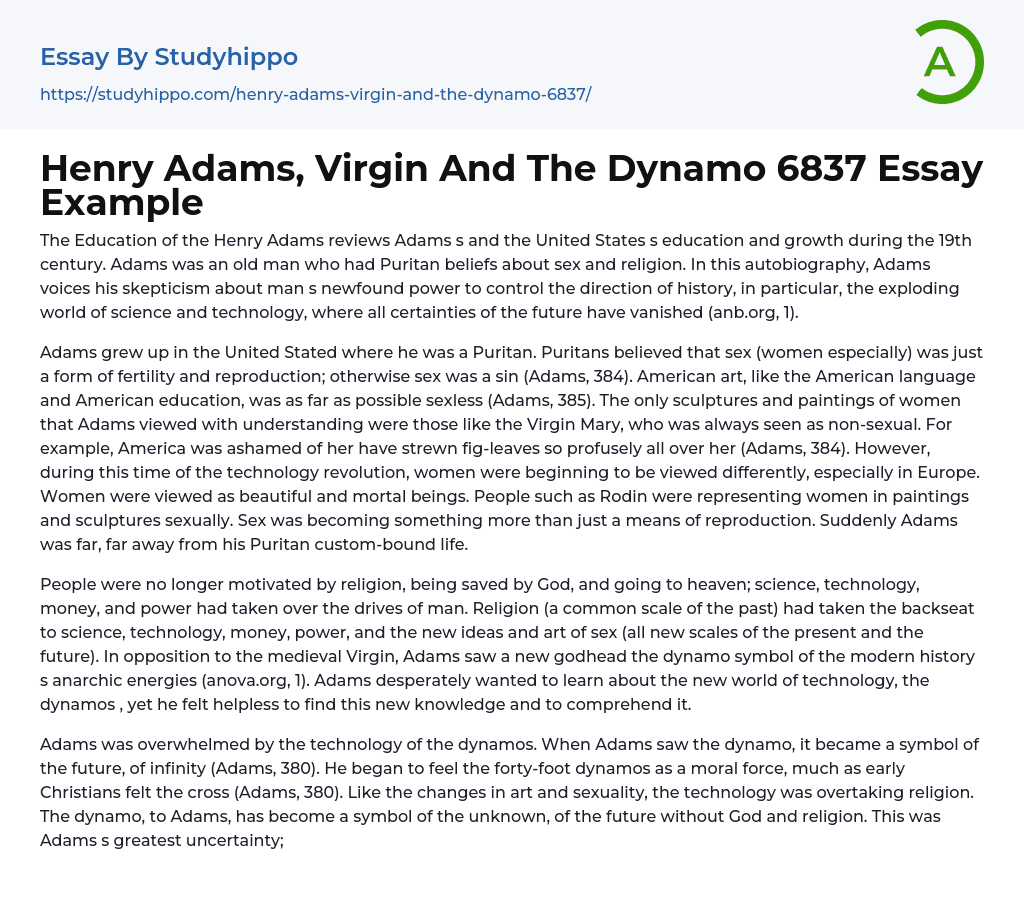The Education of the Henry Adams reviews Adams s and the United States s education and growth during the 19th century. Adams was an old man who had Puritan beliefs about sex and religion. In this autobiography, Adams voices his skepticism about man s newfound power to control the direction of history, in particular, the exploding world of science and technology, where all certainties of the future have vanished (anb.org, 1).
Adams grew up in the United Stated where he was a Puritan. Puritans believed that sex (women especially) was just a form of fertility and reproduction; otherwise sex was a sin (Adams, 384). American art, like the American language and American education, was as far as possible sexless (Adams, 385). The only sculptures and paintings of women that Adams viewed with understanding were those like the Virgi
...n Mary, who was always seen as non-sexual. For example, America was ashamed of her have strewn fig-leaves so profusely all over her (Adams, 384). However, during this time of the technology revolution, women were beginning to be viewed differently, especially in Europe. Women were viewed as beautiful and mortal beings. People such as Rodin were representing women in paintings and sculptures sexually. Sex was becoming something more than just a means of reproduction. Suddenly Adams was far, far away from his Puritan custom-bound life.
People were no longer motivated by religion, being saved by God, and going to heaven; science, technology, money, and power had taken over the drives of man. Religion (a common scale of the past) had taken the backseat to science, technology, money, power, and the new ideas and art of sex (all ne
scales of the present and the future). In opposition to the medieval Virgin, Adams saw a new godhead the dynamo symbol of the modern history s anarchic energies (anova.org, 1). Adams desperately wanted to learn about the new world of technology, the dynamos , yet he felt helpless to find this new knowledge and to comprehend it.
Adams was overwhelmed by the technology of the dynamos. When Adams saw the dynamo, it became a symbol of the future, of infinity (Adams, 380). He began to feel the forty-foot dynamos as a moral force, much as early Christians felt the cross (Adams, 380). Like the changes in art and sexuality, the technology was overtaking religion. The dynamo, to Adams, has become a symbol of the unknown, of the future without God and religion. This was Adams s greatest uncertainty; going against all of his past and beliefs and moving on into the unpredictable future.
- Puritans essays
- Afterlife essays
- Buddhism essays
- Christianity essays
- Deism essays
- Faith essays
- God essays
- Hinduism essays
- Islam essays
- Jews essays
- Judaism essays
- Monotheism essays
- New Testament essays
- Ritual essays
- Sin essays
- Soul essays
- Theology essays
- Confession essays
- Devil essays
- Miracle essays
- Monk essays
- Revelation essays
- Atheism essays
- Immortality essays
- Jainism essays
- Sinners essays
- Bible essays
- Old Testament essays
- Salvation essays
- Temple essays
- Taoism essays
- Pilgrimage essays
- Freedom Of Religion essays
- Existence of God essays
- Christian Worldview essays
- Cosmological Argument essays
- Gautama Buddha essays
- Karma essays
- Buddha essays
- Baptism essays
- Holy Spirit essays
- Jesus Christ essays
- Adam And Eve essays
- Crucifixion Of Jesus essays
- Crusades essays
- Eucharist essays
- God The Father essays
- Pope essays
- Protestantism essays
- Christian essays




